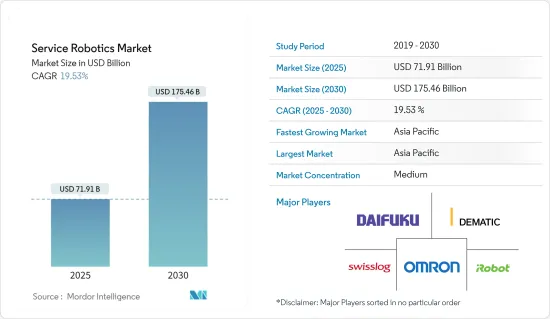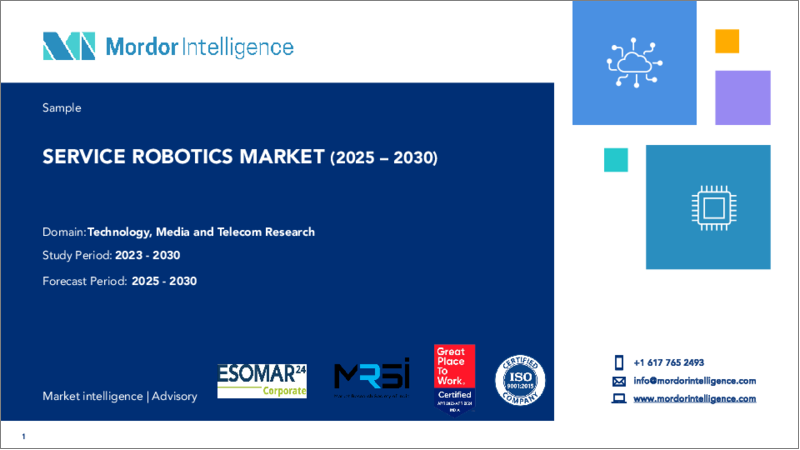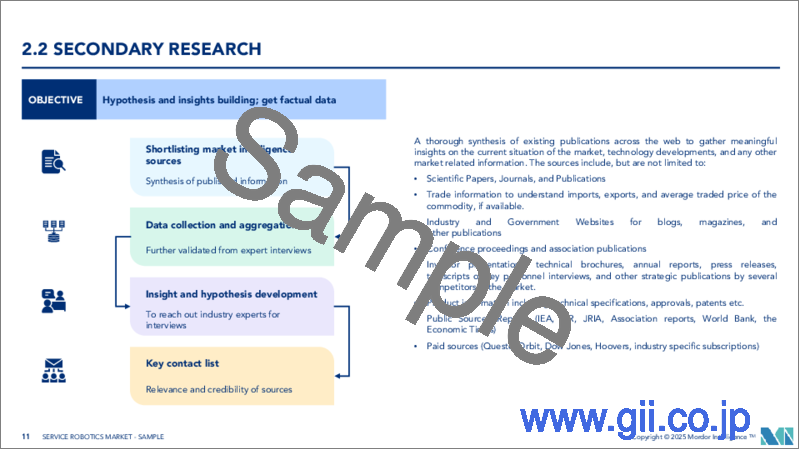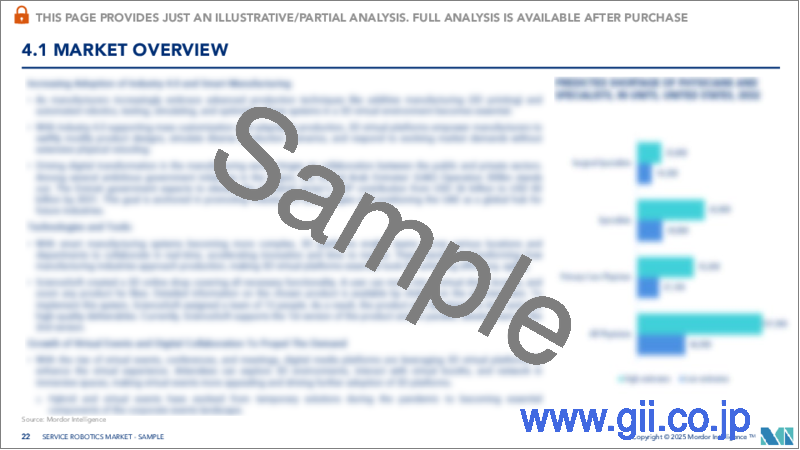|
|
市場調査レポート
商品コード
1639382
サービスロボティクス:市場シェア分析、産業動向・統計、成長予測(2025年~2030年)Service Robotics - Market Share Analysis, Industry Trends & Statistics, Growth Forecasts (2025 - 2030) |
||||||
カスタマイズ可能
適宜更新あり
|
|||||||
| サービスロボティクス:市場シェア分析、産業動向・統計、成長予測(2025年~2030年) |
|
出版日: 2025年01月05日
発行: Mordor Intelligence
ページ情報: 英文 120 Pages
納期: 2~3営業日
|
- 全表示
- 概要
- 目次
サービスロボティクスの市場規模は2025年に719億1,000万米ドルと推計され、予測期間(2025-2030年)のCAGRは19.53%で、2030年には1,754億6,000万米ドルに達すると予測されます。

サービスロボットは、正確で高品質なサービスを提供し、ユーザーの人的ミスや運用コストの削減を支援するなど、いくつかの特徴を備えており、そのため需要が増加しています。さらに、技術革新によるサービスロボティクスの急速な普及も、市場の成長を促進する主な要因の1つとなっています。
主なハイライト
- サービスロボットは、個人用(家庭用、娯楽用途など)と業務用(防衛、警備、医療補助など)の両方があり、技術の向上と手頃な価格のロボットの開発によって一般消費者への普及が大幅に進んだため、大きな人気を集めています。国際ロボット連盟(IFR)のデータによると、業務用サービスロボットの売上は2021年に約37%増加しました。
- 認知、インタラクション、操作に関する技術革新が、サービスロボティクスの魅力を高めています。技術やその他の部品プロバイダーは、ロボティクスのエコシステムを前進させてきました。例えば、ABBは最近、スイスを拠点とする新興企業セブンセンスと戦略的パートナーシップを結び、人工知能(AI)や3Dビジョンマッピングなどの技術ロジックを用いて、ABBの新しいオートノマスモバイルロボティクス(AMR)を強化しました。
- 日本や中国を含むいくつかの国々では高齢化が進んでおり、医療技術分野の成長を牽引しています。例えば、日本政府が2022年9月に発表したデータによると、日本の75歳以上の人口が初めて15%を超えました。こうした動向は企業に高齢者向け製品への投資を促し、サービスロボティクス・プロバイダーにとっては大きなチャンスとなります。
- サービスロボットは通常、掃除機や床掃除、高齢者支援、エンターテインメントなど、個人・家庭向けに導入されています。しかし、現在では複数のベンダーが新たなケースの開拓に乗り出しており、ホテルや空港ラウンジで顧客に食べ物や飲み物を届けたり、ホテルのチェックイン・チェックアウトサービスを担当したり、さらには荷物を運んだりといったタスクを実行するロボットの設計に注力しており、サービスロボットの需要を押し上げています。
- しかし、特に新興国市場における認知度の低さや、サービスロボットのコスト高といった課題が、調査対象市場の成長を阻んでいます。さらに、これらのロボットを操作するにはある程度の技術的ノウハウも必要であり、これが市場成長の大きな課題となっています。
サービスロボティクス市場の動向
業務用ロボットが市場で大きなシェアを占める
- 業務用ロボットには、現場ロボット、防衛・警備ロボット、医療支援ロボット(MAR)、公共アシスタントロボット、電気産業ロボット、建設用ロボットなどがあります。デジタル技術や自動化ソリューションがこれらの分野に浸透しつつあることが、業務用ロボットの需要を押し上げています。
- 例えば、サービスロボットは、重い人件費、人手不足、事故を克服するために建設業界に導入されています。また、人為的ミスの可能性が低くなるため、より信頼性の高い建物の建設にも役立ちます。3Dプリンターや解体ロボットなどの技術は、建設分野でロボットを採用する触媒としてさらに機能します。
- 外骨格ロボットは広報ロボットとして使用されています。ほとんどの広報ロボットは、顧客が商品を見つけたり、タスクを完了したりするのを支援するために使用されます。これらのロボットは、店舗内で顧客を案内する小売業や、接客業、銀行、ショッピングモール、家族向け娯楽施設などに配備されています。
- 業務用ロボットの主な応用分野は、運輸、接客、医療、専門清掃、農業です。輸送は、前述の年の業務用ロボットの主要な消費者の一つでした。例えば、IFRによると、2023年、米国は業務用ロボットメーカーの数が最も多く、最も近い競争相手である中国とドイツの合計数を大きく上回る。特筆すべきは、米国を含む主要国ではロボット新興企業の存在感が強く、既存企業の優位性に課題していることです。
- サービスロボットは、診断システム、ロボット支援手術や治療、リハビリテーション・システムなど、さまざまな用途で医療やヘルスケアに使用されています。COVID-19パンデミックの発生は、この分野全体のロボット需要を促進する上で重要な役割を果たしました。例えば、IFR 2021によると、医療用ロボットの販売台数は2021年に23%の成長を記録し、出荷台数は1万4,823台に達しました。
著しい成長率を示すアジア太平洋地域
- アジア太平洋地域は、特に中国、日本、韓国、インドなどの国々でサービスロボットの需要が増加している大規模な消費者基盤の存在により、世界で最も急速に成長している地域の1つです。例えば、IFRによると、2021年にはアジアで業務用ロボットの売上が約30%伸びた。
- 地域ロボット市場の開拓には、地域政府も大きな要因となっています。例えば、インドは軍事用ロボットへの投資を計画しており、今後数年間で高度なロボット兵士を配備する準備を進めています。これは、2022年1月に全インドロボット協会(AIRA)が防衛用ロボットの国産化開始を発表したことからも明らかです。
- 同様の動向は、この地域の他の国々でも観察されています。例えば、中国政府は国内のロボット産業に野心的な計画を立てています。政府は、製造業の変革とアップグレードを推進するため、人工知能(AI)や自動化とともにロボット産業をハイエンド開発の優先分野のひとつに挙げています。この推進により、中国製ロボットの世界市場シェアが高まることが期待されます。
- さらに、アジアの金融サービス企業は、株主への配当を増やし、収益性を維持するためにコストの合理化を図っており、例えばサービスロボットのように、顧客にアピールする新しいツールを自由に使えるようにしています。
- 日本や中国などの主要国でも、高齢者人口が大幅に増加しています。国連統計局(UN DESA)と中国国家統計局(NBSC)の推計によると、60歳以上の人口比率は2050年までに約38.81%まで増加すると予想されています。このような動向は、同国におけるサービスロボットの需要を促進すると予想されます。
サービスロボティクス産業の概要
サービスロボティクス市場は、大手企業が市場で大きな存在感を示しているため、適度に統合されています。しかし、需要の拡大に伴い、新規参入企業も増えており、競合と市場の細分化が進んでいます。ベンダーは、製品革新、提携、買収など、市場での存在感をさらに高めるためにさまざまな戦略を採用しています。主なプレーヤーには、ダイフク、Dematic Corp.、Swisslog Holding AG、iRobot Corporationなどがあります。
2022年9月、カナダを拠点とするロボット企業のAvidbotsは、シリーズC資金調達ラウンドで7,000万米ドルを調達しました。同社は主に自律型清掃ロボットを開発しており、倉庫、空港、ショッピングモールなどの商業環境向けに設計されたロボット床清掃機Neo 2を製造しています。
2022年9月、大手B2Bテクノロジー・ソリューション・プロバイダーであるJacky's Business Solutions社は、ギテックス・イベントで最新型のテミ・ロボット(V3)のショーケースを発表しました。同社は、Robot-as-a-service(RaaS)ビジネスモデルを採用したこの新しい個人支援ロボットを中東で発売しました。
その他の特典:
- エクセル形式の市場予測(ME)シート
- 3ヶ月間のアナリスト・サポート
目次
第1章 イントロダクション
- 調査の前提条件と市場定義
- 調査範囲
第2章 調査手法
第3章 エグゼクティブサマリー
第4章 市場洞察
- 市場概要
- 業界の魅力度-ポーターのファイブフォース分析
- 供給企業の交渉力
- 消費者の交渉力
- 新規参入業者の脅威
- 競争企業間の敵対関係
- 代替品の脅威
- COVID-19の業界への影響評価
第5章 市場力学
- 市場促進要因
- ダイナミックな産業とロボットの革新による自動化ソリューションへの需要の増加
- ヘルスケアにおける業務用ロボット需要の増加
- 市場抑制要因
- 設置とメンテナンスのコスト高
第6章 市場セグメンテーション
- 用途分野別
- 業務用
- フィールドロボット
- 業務用清掃
- 点検・メンテナンス
- 建設・解体
- 物流システム(製造業・非製造業)
- 医療用ロボット
- 救助・警備ロボット
- 防衛ロボット
- 水中システム(民間/一般)
- 人間用外骨格
- 広報ロボット
- パーソナル/家庭用
- 家事支援ロボット
- エンターテインメントロボット
- 高齢者・障害者支援ロボット
- 業務用
- 地域別
- 北米
- 欧州
- アジア
- オーストラリア・ニュージーランド
- ラテンアメリカ
- 中東・アフリカ
第7章 競合情勢
- 企業プロファイル
- Daifuku Co. Ltd
- Dematic Corp.
- Swisslog Holding AG(KUKA)
- Seegrid Corporation
- Omron Corporation
- JBT Corporation
- SSI Schaefer AG
- Grenzebach GmbH & Co. KG
- Smith & Nephew PLC
- Stryker Corp.
- Intuitive Surgical Inc.
- Knightscope Inc.
- Kollmorgen Corporation
- Brokk AB
- Husqvarna AB
- Construction Robotics LLC
- iRobot Corporation
- Ecovacs Robotics
- Neato Robotics
- Transbotics Corporation
- Medtronic PLC
- Northrop Grumman
- BAE Systems
- UBTECH Robotics Inc.
- SMP Robotics Systems Corp.
- Vision Robotics Corporation
- Naio Technologies SAS
第8章 投資分析
第9章 市場の将来展望
The Service Robotics Market size is estimated at USD 71.91 billion in 2025, and is expected to reach USD 175.46 billion by 2030, at a CAGR of 19.53% during the forecast period (2025-2030).

Service robots offer several features, such as delivering precise and high-quality service and helping users reduce human mistakes and operational expenses, due to which their demand has increased. Additionally, the rapid proliferation of service robot capabilities owing to technological innovations is also among the key factors driving the market's growth.
Key Highlights
- Service robots, both personal (for household, entertainment applications, etc.) and professional (for defense, security, medical assistance, etc.), are gaining significant popularity as technological improvement and the development of affordable robots have significantly enhanced their penetration among general consumers. According to data from the International Federation of Robotics (IFR), sales of professional service robots increased by about 37% in 2021.
- Technological innovations concerning cognition, interaction, and manipulation have made service robotics more appealing. Technology and other component providers have moved the robotics ecosystem forward. For instance, recently, ABB entered into a strategic partnership with Switzerland-based start-up Sevensense to enhance ABB's new Autonomus Mobile Robotics (AMR) offering with techn ologies such as artificial intelligence (AI) and 3D vision mapping.
- The aging population of several countries, including Japan and China, is also driving the growth in the medical technology sector, thus, creating a massive market for service robotics in the region. For instance, according to the Japanese government's data released in September 2022, for the first time, Japan's over 75s accounted for over 15% of the population. Such trends encourage companies to invest in products for the elderly, which is a massive opportunity for the service robot providers.
- Service robots are usually deployed for personal/household purposes, like vacuum and floor cleaning, elderly assistance, and entertainment. However, several vendors have now started exploring new cases and are focusing on designing robots to perform tasks, such as delivering food and drinks to customers at hotels and airport lounges, handling check-in and check-out services at hotels, and even carrying luggage, which is boosting the demand for service robots.
- However, the factors such as low awareness, especially in developing regions, and the higher cost of service robots are challenging the growth of the studied market. Furthermore, a certain degree of technical know-how is also required to operate these robots, which is a significant challenge for the market's growth.
Service Robotics Market Trends
Professional Use of Robots to Account for a Significant Share in the Market
- Professional robots consist of field robots, defense, and security robots, medical assisting robots (MAR), public assistant robots, electrical industry robots, and robots for construction purposes. The increasing penetration of digital technologies and automation solutions across these sectors drives the demand for professional robots.
- For instance, service robots are deployed in the construction industry to overcome heavy labor costs, shortages, and accidents. It also helps construct more reliable buildings since there is less chance of human error. Technologies like 3D printing and demolition robots further act as catalysts in adopting robots in the construction sector.
- Exoskeleton robots are used as public relations robots. Most public relations robots are used to assist customers in finding an item or completing a task. These robots are deployed in retail to guide customers around a store and in the hospitality industry, banks, shopping malls, family entertainment centers, and more.
- Major application areas for professional robots are transportation, hospitality, medical, professional cleaning, and agriculture. Transportation was among the leading consumer of professional robots in the aforementioned year. For instance, according to IFR, in 2023, the United States boasts the largest number of professional service robot manufacturers, significantly surpassing the combined count of China and Germany, its closest competitors. Notably, leading nations, including the United States, see a robust presence of robotics startups, challenging the dominance of established firms.
- Service robots are used in medical and healthcare for various applications, including diagnostic systems, robot-assisted surgery or therapy, rehabilitation systems, etc. The outbreak of the COVID-19 pandemic played an important role in driving the demand for robots across the sector. For instance, according to IFR 2021, a 23% growth in the sales of medical robots was recorded in 2021, with the number of shipments touching 14,823 units.
Asia Pacific to Exhibit a Significant Growth Rate
- The Asia Pacific is one of the fastest-growing regions in the world, owing to the presence of a large consumer base, among which the demand for service robots is increasing, especially in countries such as China, Japan, South Korea, and India, among others. For instance, according to IFR, in 2021, the sales of professional robots grew by about 30% in Asia.
- Regional governments are also a significant factor in developing a regional robotics market. For instance, India plans to invest in military robotics, and the country is preparing to deploy advanced robotic soldiers in the next few years. This is evident from the fact that in January 2022, the All India Robotics Association (AIRA) announced the beginning of indigenous manufacturing of defense robots.
- A similar trend has been observed across other countries of the region as well. For instance, the Chinese government has ambitious plans for the country's robotics industry. The government has listed the robotics industry, along with artificial intelligence (AI) and automation, as one of the priority sectors for high-end development to push forward the transformation and upgradation of the manufacturing industry. This push is expected to raise the global market share of Chinese-made robots.
- Further, financial services companies in Asia are looking to streamline costs to boost dividends to shareholders, maintain profitability, and have a new tool at their disposal that appeals to customers, for example, service robots.
- Some major countries, such as Japan, China, etc., are also witnessing significant growth in the aged population. According to the estimation of UN DESA and the National Bureau of Statistics of China (NBSC), the percentage of the population aged 60 and above is expected to grow to about 38.81% by 2050. Such trends are expected to drive the demand for service robots in the country.
Service Robotics Industry Overview
The Service Robotics market is moderately consolidated, as major players have a significant market presence. However, with the demand growing, new players are also entering the market, driving competition and the market toward a fragmented stage. Vendors are adopting various strategies to consolidate further their market presence, including product innovation, partnerships, acquisitions, etc. Some major players include Daifuku Co. Ltd, Dematic Corp., Swisslog Holding AG, and iRobot Corporation.
In September 2022, Avidbots, a robotics company based in Canada, raised USD 70 million in the Series C funding round. The company primarily develops autonomous cleaning robots and has built Neo 2, a robotic floor cleaner designed for commercial environments such as warehouses, airports, and shopping malls.
In September 2022, Jacky's Business Solutions, a leading B2B technology solutions provider, announced a showcase of its latest iteration of Temi Robot (V3) at the Gitex event. The company launched this new personal assistance robot in the Middle East with Robot-as-a-service (RaaS) business model.
Additional Benefits:
- The market estimate (ME) sheet in Excel format
- 3 months of analyst support
TABLE OF CONTENTS
1 INTRODUCTION
- 1.1 Study Assumptions and Market Definition
- 1.2 Scope of the Study
2 RESEARCH METHODOLOGY
3 EXECUTIVE SUMMARY
4 MARKET INSIGHTS
- 4.1 Market Overview
- 4.2 Industry Attractiveness - Porter's Five Forces Analysis
- 4.2.1 Bargaining Power of Suppliers
- 4.2.2 Bargaining Power of Consumers
- 4.2.3 Threat of New Entrants
- 4.2.4 Intensity of Competitive Rivalry
- 4.2.5 Threat of Substitutes
- 4.3 Assessment of COVID-19 impact on the industry
5 MARKET DYNAMICS
- 5.1 Market Drivers
- 5.1.1 Increasing Demand for Automated Solutions from Dynamic Industries and Robot Innovations
- 5.1.2 Increased Demand for Professional Robots in Healthcare
- 5.2 Market Restraints
- 5.2.1 High Cost of Installation and Maintenance
6 MARKET SEGMENTATION
- 6.1 By Field of Application
- 6.1.1 Professional
- 6.1.1.1 Field Robots
- 6.1.1.2 Professional Cleaning
- 6.1.1.3 Inspection and Maintenance
- 6.1.1.4 Construction and Demolition
- 6.1.1.5 Logistics Systems (Manufacturing and Non-manufacturing)
- 6.1.1.6 Medical Robots
- 6.1.1.7 Rescue and Security Robots
- 6.1.1.8 Defense Robots
- 6.1.1.9 Underwater Systems (Civil/General)
- 6.1.1.10 Powered Human Exoskeletons
- 6.1.1.11 Public Relation Robots
- 6.1.2 Personal/Domestic
- 6.1.2.1 Robots for Domestic Tasks
- 6.1.2.2 Entertainment Robots
- 6.1.2.3 Elderly and Handicap Assistance
- 6.1.1 Professional
- 6.2 By Geography
- 6.2.1 North America
- 6.2.2 Europe
- 6.2.3 Asia
- 6.2.4 Australia and New Zealand
- 6.2.5 Latin America
- 6.2.6 Middle East and Africa
7 COMPETITIVE LANDSCAPE
- 7.1 Company Profiles
- 7.1.1 Daifuku Co. Ltd
- 7.1.2 Dematic Corp.
- 7.1.3 Swisslog Holding AG (KUKA)
- 7.1.4 Seegrid Corporation
- 7.1.5 Omron Corporation
- 7.1.6 JBT Corporation
- 7.1.7 SSI Schaefer AG
- 7.1.8 Grenzebach GmbH & Co. KG
- 7.1.9 Smith & Nephew PLC
- 7.1.10 Stryker Corp.
- 7.1.11 Intuitive Surgical Inc.
- 7.1.12 Knightscope Inc.
- 7.1.13 Kollmorgen Corporation
- 7.1.14 Brokk AB
- 7.1.15 Husqvarna AB
- 7.1.16 Construction Robotics LLC
- 7.1.17 iRobot Corporation
- 7.1.18 Ecovacs Robotics
- 7.1.19 Neato Robotics
- 7.1.20 Transbotics Corporation
- 7.1.21 Medtronic PLC
- 7.1.22 Northrop Grumman
- 7.1.23 BAE Systems
- 7.1.24 UBTECH Robotics Inc.
- 7.1.25 SMP Robotics Systems Corp.
- 7.1.26 Vision Robotics Corporation
- 7.1.27 Naio Technologies SAS






